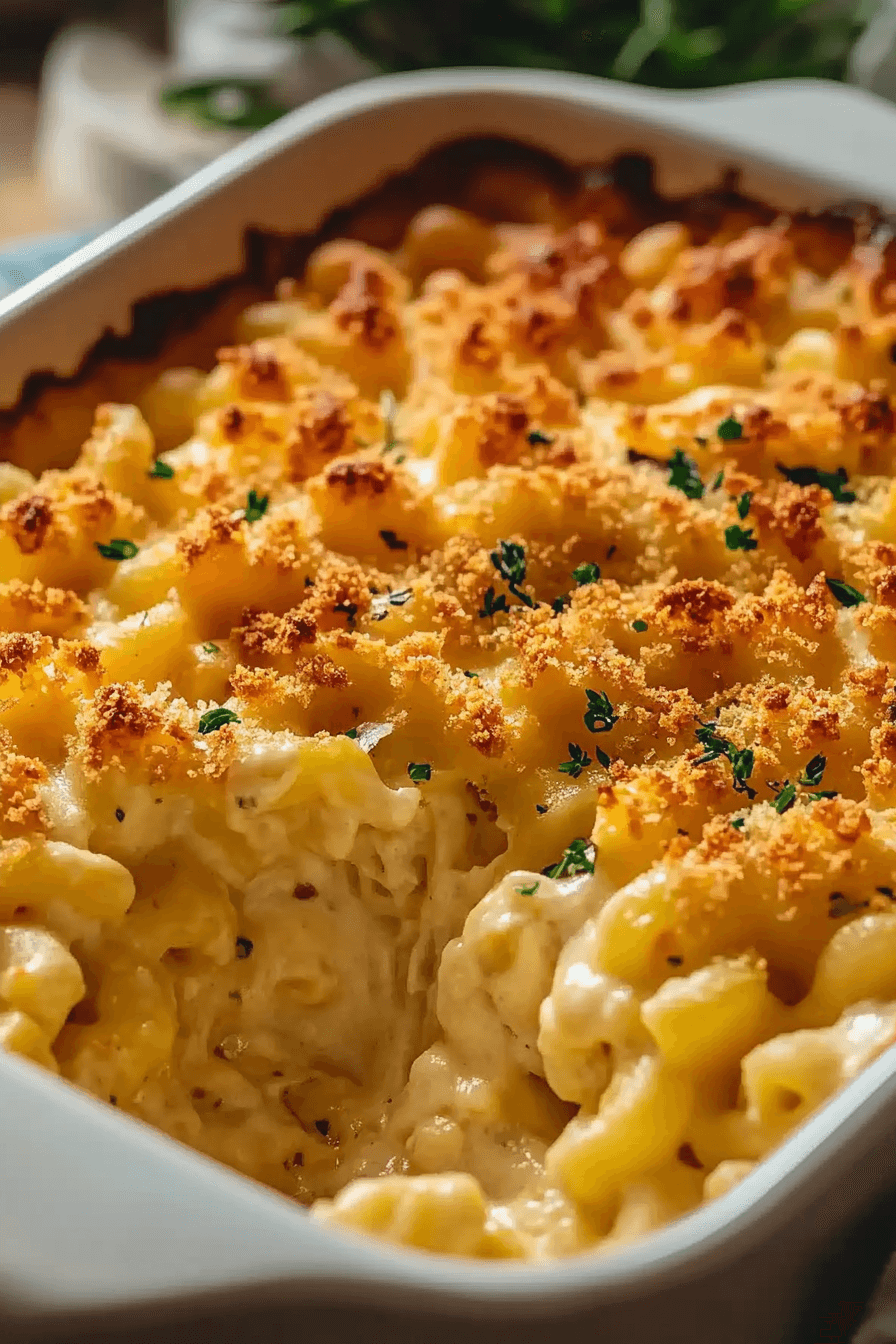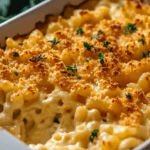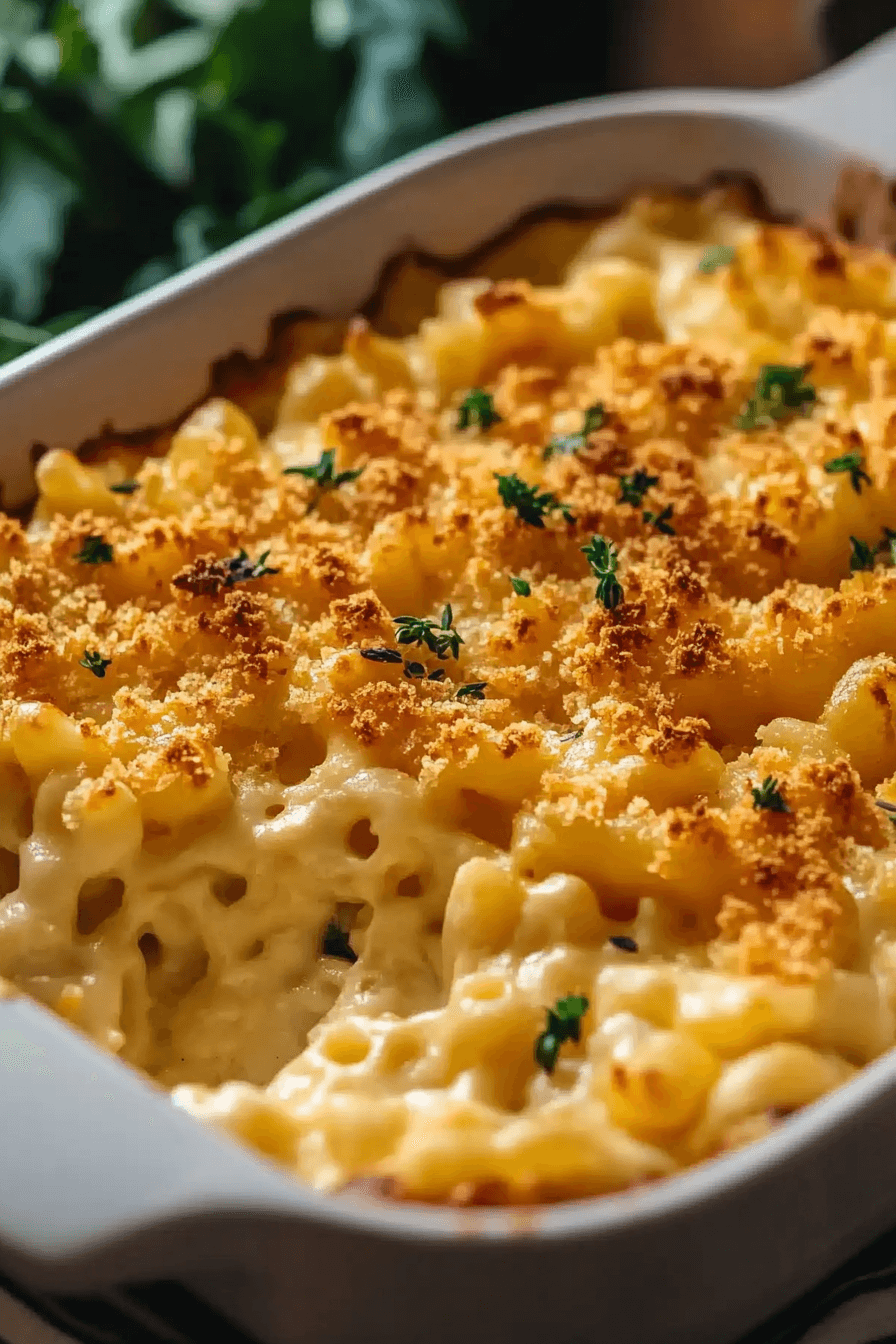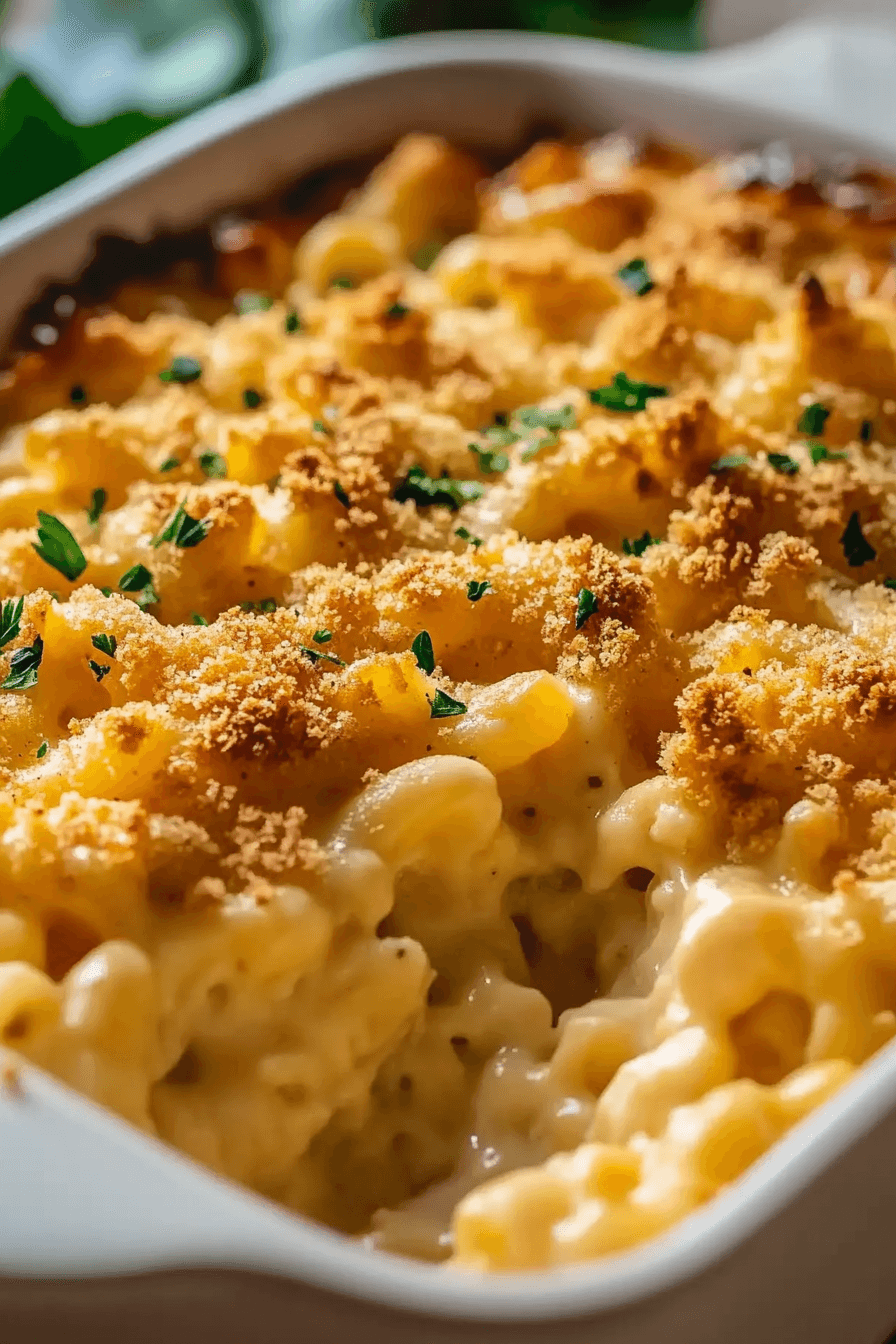Introduction to Homemade Mac and Cheese Casserole
Welcome to Valentina’s kitchen, where we’re diving into the delightful world of homemade mac and cheese casserole. This classic comfort food is a creamy, cheesy dream that will satisfy anyone’s craving for a warm, hearty meal. Creating this beloved dish at home is not only simple but also offers countless opportunities to make it your own. Whether you’re a busy parent, a student on the run, or just someone looking to unwind with a delightful meal, a homemade mac and cheese casserole is your go-to solution. Let’s make this comforting dish together and discover why it’s a timeless favorite.
Jump To
- 1. Introduction to Homemade Mac and Cheese Casserole
- 2. Benefits and Advantages of Homemade Mac and Cheese Casserole
- 3. Ingredients Overview
- 4. How to Prepare the Perfect Homemade Mac and Cheese Casserole: Step-by-Step Guide
- 5. Mastering Homemade Mac and Cheese Casserole: Advanced Tips and Variations
- 6. How to Store Homemade Mac and Cheese Casserole: Best Practices
- 7. Nutritional Value of Homemade Mac and Cheese Casserole
- 8. FAQs: Frequently Asked Questions About Homemade Mac and Cheese Casserole
- 9. Homemade Mac and Cheese Casserole: Creamy and Irresistible
Benefits and Advantages of Homemade Mac and Cheese Casserole
Creating a homemade mac and cheese casserole is not just about its delicious taste; it also offers numerous advantages over store-bought alternatives. Firstly, knowing exactly what goes into your dish can’t be understated, particularly if you are health-conscious or have dietary restrictions. The simplicity of this recipe means that you can put together a wholesome meal in no time, making it perfect for busy individuals and families alike. Moreover, it allows you to explore various cheese combinations tailored to individual preferences. Homemade versions are typically more flavorful and satisfying, filled with fresh, quality ingredients. Learning how to master this dish makes for a valuable skill that you’ll come back to time and time again.
Ingredients Overview
Essential Ingredients for Homemade Mac and Cheese Casserole
- Elbow Macaroni: 2 cups. This classic pasta shape holds the creamy sauce well.
- Butter: 2 tablespoons, for making the roux and adding richness.
- All-Purpose Flour: 2 tablespoons, used to thicken the sauce.
- Milk: 2 cups, offers a creamy base for the sauce. For extra creaminess, add 1/2 cup of cream.
- Cheddar Cheese: 2 cups shredded. Sharp cheddar is preferred for its robust flavor, but feel free to mix with other cheeses like Gruyere or Parmesan.
- Breadcrumbs: 1/2 cup, optional for topping, to add a crispy layer.
- Salt and Pepper: To taste, for seasoning.
This dish is adaptable for various dietary needs. For a vegan version, consider using plant-based milk and cheese alternatives. Gluten-free pasta and flour work seamlessly for those avoiding gluten. Furthermore, using lighter cheese and milk options can help keep the dish low-calorie.
Dietary Substitutions to Customize Your Homemade Mac and Cheese Casserole
Whether you need a vegan, gluten-free, or low-calorie version of homemade mac and cheese casserole, you can easily adapt the recipe to suit your needs:
- Vegan Option: Use dairy-free butter, almond or soy milk, and plant-based cheeses. Nutritional yeast can also add a cheesy flavor without the dairy.
- Gluten-Free Option: Replace regular pasta with gluten-free pasta and use gluten-free flour for the roux. Ensure other ingredients like breadcrumbs are gluten-free if using.
- Low-Calorie Option: Opt for skim milk or a milk-alternative with fewer calories. Reduced-fat cheese can help cut down on calories without sacrificing flavor, though using extra herbs or spices might enhance the taste.
This flexibility ensures that this beloved comfort food can be enjoyed by everyone, adapting to various preferences without losing its creamy, satisfying character.
How to Prepare the Perfect Homemade Mac and Cheese Casserole: Step-by-Step Guide
Creating a delicious homemade mac and cheese casserole is simple with these easy-to-follow steps. Note how they can be adjusted for different dietary preferences:
- First Step: Prepare the Pasta – Start by boiling water in a large pot. Add a pinch of salt, then the elbow macaroni. Cook the pasta until it’s al dente, which typically takes about 7–8 minutes. Drain the pasta and set it aside.
- Second Step: Make the Roux – In a medium saucepan, melt the butter over medium heat. Add the flour and whisk continuously for about 2 minutes, until the mixture is golden and bubbling. This will thicken your sauce to the perfect consistency.
- Third Step: Create the Cheese Sauce – Gradually pour in the milk while continuing to whisk, ensuring it smooths out evenly. Bring the mixture to a gentle simmer, then add the shredded cheddar cheese and any other cheese of your choice. Stir until the cheese has melted completely and the sauce is velvety. Season with salt and pepper to your liking.
- Fourth Step: Combine Pasta and Sauce – Return the drained pasta to the pot. Pour the cheese sauce over the pasta and mix until each piece is coated evenly.
- Fifth Step: Prepare the Casserole – Preheat your oven to 350°F (175°C). Transfer the macaroni and cheese mixture to a greased casserole dish. If you prefer a crispy top, sprinkle breadcrumbs or additional cheese over the top.
- Sixth Step: Bake – Place the casserole in the preheated oven. Bake for 20–25 minutes or until the top is bubbly and golden. If you are preparing a vegan version, same directions apply.
- Final Step: Serve and Enjoy – Remove the casserole from the oven and let it cool for a few minutes before serving. This dish makes a wonderful addition to any meal or a hearty main course, especially for busy parents or students who enjoy home-cooked meals.
Adapting these steps for dietary needs, like using alternative flours or cheeses, is straightforward. The key to success is in the cheese sauce — ensuring it’s smooth by whisking will make a truly irresistible homemade mac and cheese casserole.

Mastering Homemade Mac and Cheese Casserole: Advanced Tips and Variations
Creating the perfect homemade mac and cheese casserole is an art that goes beyond just following a recipe. Here, we focus on advanced tips and fun variations, ensuring your dish stands out and leaves everyone craving more.
Advanced Tips for Success
- Choose the Right Cheese Blend: While cheddar is a classic choice, try incorporating a mix of cheeses like Gruyère, Fontina, or even a smoky Gouda to enhance the flavor.
- Master the Roux: The roux forms the base for the creamy sauce. Whisk equal parts butter and flour for about two minutes over medium heat to avoid any raw flour taste, then slowly add milk while continuously whisking to prevent lumps.
- Season Generously: Enhance the cheesy sauce with garlic powder, onion powder, or a dash of cayenne pepper for a subtle kick. Seasoning adds depth and complexity.
- Pasta Perfection: Cooking your pasta al dente ensures it doesn’t overcook in the oven. The pasta will absorb the sauce and continue cooking as it bakes, resulting in the perfect texture.
- Breadcrumb Topping: For an irresistible crunchy topping, combine breadcrumbs with melted butter and spread evenly over the casserole before baking.
Creative Variations to Try
Don’t shy away from personalizing your mac and cheese casserole with exciting variations:
- Vegetable Boost: Stir in roasted broccoli, sautéed mushrooms, or diced tomatoes for added texture and nutrients.
- Protein Power: Add cooked bacon, shredded chicken, or even lobster for a luxurious touch.
- Spicy Sensation: Incorporate jalapeños or a sprinkle of paprika for a fiery twist.
- International Flair: Experiment with different regional cheeses or flavors, such as Mexican with pepper jack and chorizo or Mediterranean with feta and olives.
Trying these advanced tips and variations can transform your homemade mac and cheese casserole into a culinary masterpiece that suits family dinners or special gatherings alike. For more delicious and unique recipe ideas, visit our Cheesy Garlic Parmesan Spaghetti with Cream Cheese and Tomato Sauce.
How to Store Homemade Mac and Cheese Casserole: Best Practices
Proper storage is crucial to maintaining the taste and texture of your homemade mac and cheese casserole. Here’s how you can store leftovers effectively:
Refrigeration Tips
- Cool First: Allow the casserole to cool to room temperature before storing it to prevent condensation, which can cause sogginess.
- Use Airtight Containers: Transfer leftovers to airtight containers to lock in moisture and flavors, storing them in the refrigerator for up to 3-4 days.
- Reheat Gently: For best results, reheat in the oven at 350°F (177°C) until heated through, or use a microwave, adding a splash of milk to revive the creaminess.
Freezing Techniques
- Pre-Prep for Freezing: If planning to freeze leftovers, avoid adding breadcrumb toppings as they become mushy. Instead, add them fresh when ready to bake.
- Deep Freeze Method: Transfer to a freezer-safe, airtight container, or tightly wrap in aluminum foil and place inside zip-lock bags. This keeps your casserole safe from freezer burn for up to 3 months.
- Thawing and Reheating: Thaw in the refrigerator overnight before reheating. For best results, reheat in the oven at 350°F (177°C) to restore texture and flavor.
Storing your delicious homemade mac and cheese casserole correctly ensures you enjoy its creamy goodness even days or weeks later. For more insights into making your mac and cheese healthier, consider learning about mac and cheese nutrition facts on Healthline.

Nutritional Value of Homemade Mac and Cheese Casserole
Understanding the nutritional value of your homemade mac and cheese casserole is essential for those who are diet-conscious or simply interested in knowing what goes into their favorite comfort food. This classic dish boasts a balanced blend of macronutrients, providing energy and satisfaction. Let’s break down the nutritional profile to give you insights into this indulgent treat.
A typical serving of homemade mac and cheese casserole offers:
- Calories: Approximately 400-600 calories per serving, which can vary based on the ingredients used.
- Protein: Ranges from 15-25 grams, largely dependent on the type and amount of cheese and milk used.
- Fats: Typically around 20-30 grams, with proportions of saturated and unsaturated fats varying by choice of cheese and butter.
- Carbohydrates: Approximately 40-60 grams per serving, predominantly from the pasta.
- Fiber: Usually 2-4 grams, depending on the type of pasta and potential vegetable additions.
Health Benefits: The casserole provides calcium and vitamin D from cheese and milk. Choosing whole grain pasta can increase fiber content, further benefiting digestive health. Reducing the cheese or opting for low-fat varieties can help decrease fat content.
For those on a low-carb journey, it’s useful to learn more about the carbohydrate impact of your favorite foods. For detailed information, check out Carb Manager’s analysis on macaroni and cheese casseroles.
As you can see, understanding the nutrient breakdown can aid in meal planning, especially if you love enjoying delightful dishes like homemade mac and cheese casserole. For more nutritional insights, visit another resource like Healthline’s mac and cheese calorie guide.
FAQs: Frequently Asked Questions About Homemade Mac and Cheese Casserole
The homemade mac and cheese casserole is a beloved dish, but it sometimes raises questions, especially for those cooking it for the first time. Let’s address some common inquiries to help you achieve the perfect balance of flavor and texture.
What type of pasta is best for homemade mac and cheese casserole?
Elbow macaroni is a classic choice for this dish due to its shape and size, which hold the creamy cheese sauce well. However, you can experiment with cavatappi, rotini, or penne to add a personal touch.
How do I prevent the cheese sauce from becoming grainy?
To prevent a grainy texture, ensure you slowly add the cheese to the roux mixture, continuously stirring. Using freshly shredded cheese instead of pre-packaged can also enhance smoothness as it melts more uniformly.
Can I prepare homemade mac and cheese casserole ahead of time?
Yes, you can prepare the casserole a day in advance by following all preparation steps except the final baking. Cover and refrigerate it, then bake it when you’re ready to serve. This makes it a convenient choice for gatherings or busy nights.
Why is it important to cook the pasta al dente for mac and cheese?
Cooking pasta al dente is key because it ensures the pasta holds its shape and texture while baking in the casserole, without becoming mushy. The pasta will continue cooking when baked, absorbing flavors and achieving the right consistency.
For unique flavor additions, consider trying other pasta recipes on Valentina Recipes or cream-based pasta delights to expand your culinary repertoire.
Print
Homemade Mac and Cheese Casserole: Creamy and Irresistible
- Total Time: 40 minutes
Description
🧀 Indulge in the ultimate comfort food with this homemade mac and cheese casserole—rich, creamy, and baked to golden perfection! 🍽️
🔥 Packed with gooey cheese and a crispy topping, it’s a must-try dish for cozy family dinners and holiday gatherings! 🥄✨
Ingredients
Elbow macaroni
Butter
Flour
Milk
Cheddar cheese (sharp recommended)
Gruyere cheese (optional)
Parmesan cheese (optional)
Salt
Black pepper
Breadcrumbs (optional, for topping)
Heavy cream (optional, for extra creaminess)
Eggs (optional, for a custard-like texture)
Bacon (optional, for added flavor)
Vegetables (optional, such as broccoli or spinach)
Garlic powder (optional, for seasoning)
Paprika (optional, for seasoning)
Instructions
1. Boil the elbow macaroni until al dente, then drain and set aside.
2. In a saucepan, melt butter over medium heat.
3. Stir in flour and cook for a minute to form a roux.
4. Slowly whisk in milk, stirring constantly until the mixture thickens.
5. Reduce heat and add shredded cheese, stirring until fully melted and smooth.
6. Season the cheese sauce with salt, pepper, and any desired spices.
7. Combine the cooked pasta with the cheese sauce, mixing well.
8. Transfer the mac and cheese mixture into a greased casserole dish.
9. Sprinkle additional cheese or breadcrumbs on top for a crispy crust.
10. Bake in a preheated oven at 350°F (175°C) for 20-25 minutes until golden and bubbly.
11. Let the casserole cool for a few minutes before serving.
12. Enjoy as a main dish or side dish for any occasion.
Notes
Use freshly shredded cheese instead of pre-shredded for a smoother, creamier sauce.
Cook the pasta until just al dente to prevent it from becoming too soft while baking.
For extra flavor, mix different cheeses like sharp cheddar, gruyere, and parmesan in the sauce.
- Prep Time: 10
- Cook Time: 30
- Category: Main Dish
- Method: Baked
- Cuisine: American


